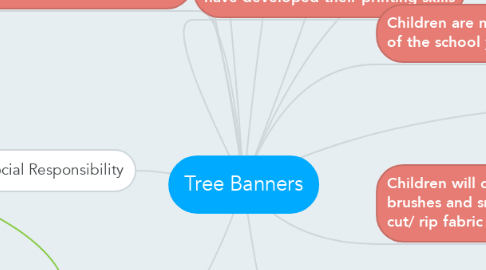
1. Children will personalize their own tree
2. Children will develop velcro additions to represent different seasons ie: snow for winter, buds for spring, green leaves for summer and orange leaves for fall
3. Banners will be used to show off at graduation
4. Banners are made of recycled materials and children will gather willow sticks for the top and bottom
5. Children will add names once they have developed their printing skills
6. Personal and Social Responsibility
6.1. The child develops positive attitudes and behaviours toward learning. The child: • perceives self as capable of learning • shows respect for self • demonstrates curiosity, interest and some persistence in learning activities • participates actively in learning tasks • shows willingness to explore and expand learning, and to try new things • identifies and begins to demonstrate effective listening; e.g., actively listens and responds appropriately • expresses preferences, and identifies basic personal likes and dislikes.
7. Environment and Community Awareness
7.1. The child uses materials in the environment and community and becomes aware of how others use materials.
7.1.1. • uses simple tools in a safe and appropriate manner • recognizes the need to care for materials, and uses materials without wasting them --manipulates or uses materials for a purpose; e.g., water, sand, wood and fabric
7.2. • identifies familiar shapes and symbols in the environment and community; e.g., circles, squares, stop signs and traffic lights
7.3. • recognizes that some activities or events occur at particular times; e.g., recess, lunch, bedtime and seasonal changes
8. Citizenship and Identity
8.1. K.1 I Am Unique:• the child values his or her own unique characteristics, interests, gifts and talents
8.2. • develops skills of historical thinking: o recognizes that some activities or events occur at particular times of the day or year
9. Children are measured at the beginning of the school year and at the end
10. Children will develop control of large brushes and small brushes and will cut/ rip fabric
11. Early Numeracy: Shape and Space (Measurement )
11.1. Use direct comparison to compare two objects based on a single attribute, such as length (height),
12. Early Literacy
12.1. 4.2 Attend to Conventions
12.1.1. • capitalize first letter of own name
12.2. 4.3 Present and Share
12.2.1. • follow one- or two-step instructions
12.3. 5.1 Respect Others and Strengthen Community
12.3.1. • share stories, using rhymes, rhythms, symbols, pictures and drama to celebrate individual and class accomplishments
13. Creative Expression
13.1. • responds to and interprets visual images, by viewing natural forms, everyday objects and artworks
13.2. • explores familiar materials in new ways
13.3. • begins to select from familiar media, tools or materials to express thoughts, ideas, feelings and experiences; e.g., art materials, musical instruments, dance, story and puppets.
14. Physical Skills and well Being
14.1. The child develops fine motor and perceptual motor skills through participation in a variety of activities.
14.1.1. The child: • develops fine motor skills involving finger speed, arm steadiness, arm and hand precision, finger and hand dexterity, and the manipulation of small materials • develops perceptual–motor skills through activities involving eye–hand coordination; e.g., looking at picture books, stringing beads, cutting, pasting, drawing and collage work.
14.2. The child develops attitudes and behaviours that promote a healthy lifestyle, wellness and safety for self and others.
14.2.1. • identifies general physical changes that have occurred since birth; e.g., height, size of feet, weight and body shape
